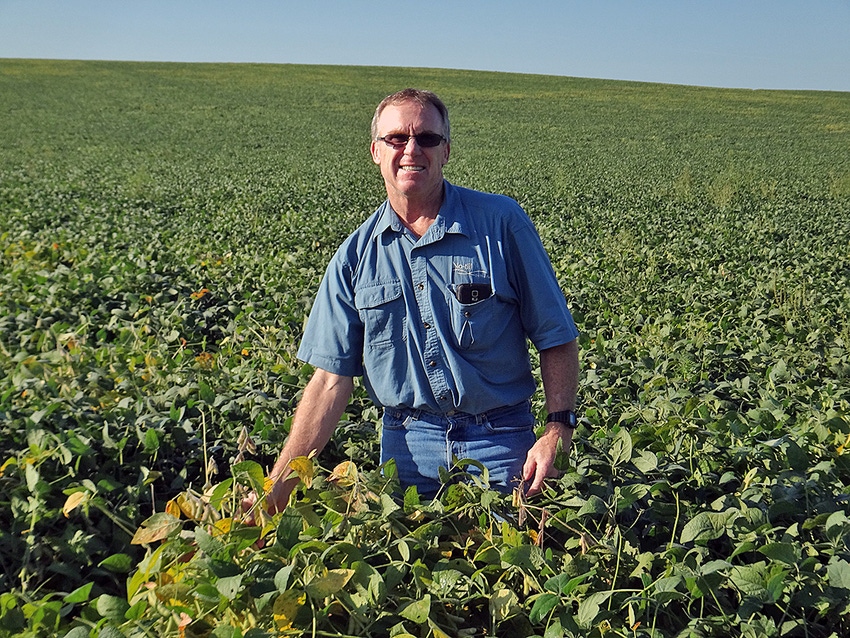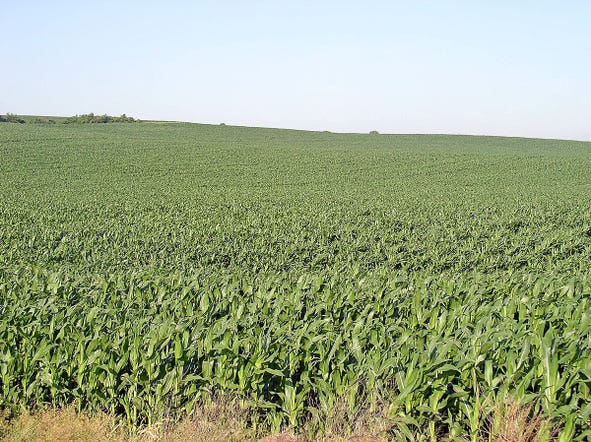
From plow to no-till
Think Different: No-till and cover crops are natural partners. If you are transitioning to no-till, plant cover crops on the same ground, suggests Dan Gillespie, an experienced no-tiller and cover-cropper from Meadow Grove, Neb. Early in his transition to no-till, Gillespie's soybean yields dipped 2 or 3 bu./acre due to the rapid buildup of corn residue. But that turned out to be temporary. The soil's biological activity hadn't yet ramped up fully to cycle the extra surface residue, he says. Keeping living roots in the soil from thaw to freeze-up is the best way to stimulate soil microbial activity and expedite the soil's transition to a no-till system, he says. Just be careful not to overburden a new no-till system with a cover crop that has too high a carbon-to-nitrogen ratio until you've built up the soil's biological activity.
October 23, 2015

Dan Gillespie’s “epiphany moment” came in spring 1986. “We got a rain on frozen soil that carved a gully a foot wide and 3 feet deep” in one of his fall-plowed cornfields.
The ravaged field convinced him it was time to do something different. “I said, That’s it! I was tired of seeing my soil erode. I’d been reading about no-till in the eastern Corn Belt and I decided to try it.”
Today, the Meadow Grove, Neb., corn and soybean grower “armors” his topsoil with a combination of no tillage and cover crops. Twenty-four years of continuous no-till, plus a decade of cover cropping, has largely halted water erosion on his 410-acre farm in northeastern Nebraska, he says. Soil biological activity is flourishing and soil organic matter has climbed by more than a third.
Manage soil health
Other farmers can learn a lot about soil health management from Gillespie, says agronomist Bryan Dunlap, of BD Ag Enterprises, Inc., Newman Grove, Neb., who has worked with Gillespie for many years. “He’s very open to trying new things, and is very focused on continually trying to make his system better. That’s his passion.”
Gillespie farms silty clay loam hills, which slope 4% to 16%. He eased into no-till, that first year planting 25 acres of dryland corn into soybean residue without tillage. “It worked great.” The next year he no-tilled 100 dryland acres.
In 1988, he tried eliminating tillage for irrigated corn, too. When he compared yields under no-till and spring field cultivation, “the no-till out-yielded the conventional by 16 bu./acre.” By 1991, he had converted his entire farming operation to no-till.
As he gained no-till experience, Gillespie learned to plant corn a little deeper in the soil — about 2.5 inches. That provides more consistent soil temperature and “gives a better chance of uniform emergence,” says Dunlap, his agronomist.
Gillespie also pays close attention to the settings on his Dawn row cleaners, aiming “to move no residue except an occasional clump. In our highly-erodible hills, if you move too much residue, you make a channel for heavy rains to wash down.” Setting up planting equipment correctly for your soils and field conditions is one of the keys to successful no-till, Dunlap adds.
Help from cover crops
Cycling soybean residue too fast
Gillespie intensified his soil protection efforts in 2005, after heavy spring rains etched small gullies in some fields. If you’re seeing ephemeral gullies — those small channels that farmers usually closed with a disk — “it tells you you’re still having soil loss, so you’re not approaching sustainable,” says Gillespie, who is also a part-time NRCS no-till specialist in the Lower Elkhorn Natural Resources District.
“My problem was that after 13 years of continuous no-till, my soil biology was cycling my soybean residue faster, and I was losing my protective residue cover.” This is a common observation, says Cheryl Reese, a soil scientist at South Dakota State University. �“There are many components of soil biology that are sensitive to tillage. It’s a diverse world underground and how we manage the soil affects that diversity.”
Gillespie decided he needed to augment the soil cover in the soybean half of his rotation. “The problem with soybean residue is, it’s fragile and there isn’t much of it,” Reese says. “Bean ground is so much more prone to erosion in the springtime because of that.”
Cover crops in beans stopped erosion
In fall 2005, Gillespie planted his first cover crops on two harvested soybean fields. He drilled cereal rye right after combining, seeding 40 acres as a trial. “I saw the benefits immediately, especially in the sandy, lower-organic-matter soils.”
Encouraged, he aerial seeded cereal rye on 80 acres of soybean ground in fall 2006. The next spring, a 7-inch rainfall caused severe soil erosion throughout the Battle Creek Watershed, tearing up tilled and newly planted fields, and washing mounds of residue into waterways.
But Gillespie’s cover-cropped field “didn’t wash.”
Over the next few years, Gillespie planted cover crops on more soybean acres, experimenting with seeding methods and timing. For several years, he aerial seeded cereal rye at soybean senescence, about the first week of September. “But I found the results erratic.” Establishment was often uneven, hindering erosion control and weed suppression, and complicating herbicide management.
Gillespie prefers to drill cereal rye after soybean harvest for a more uniform stand, even though later planting limits fall growth. But the drilled rye catches up to earlier-planted rye in the spring, he says, when the soil is most in need of protection. “From early May to June — when corn is planted and soybean residue has degraded — is when fields are most vulnerable.”
Gillespie now seeds all his soybean fields to covers immediately after harvest. The exception was fall 2012, when it was too dry. In the spring, he kills the cover crop with pre-plant herbicide application, then seeds corn, adding 10-34-0 starter in the furrow.
A few years ago, Gillespie started drilling cereal rye into corn residue, as well. Because of the late date, “that’s often a dormant seeding,” but the cover comes up in early spring.
If conditions are wet, he plants soybeans directly into the living rye, using the cover as “a water management tool,” then kills it a week or so later with his first postemergence herbicide application. “Soybeans and cereal rye grow well together, as long as there is adequate moisture. But it needs to be managed carefully.” If conditions are dry, he kills the cover crop first, then drills soybeans into the residue.
Organic matter growth
Gillespie’s system of continuous no-till plus cover crops has nearly eliminated gully erosion on his farm, he says. “I haven’t had to work on any flow areas for five years now.”
His soil organic matter has climbed from 2.0% or 2.5% 20 years ago, to 3.5% or 4%. Some fields are now over 4%. From 1991 to 2004, organic matter gains averaged about 0.1% per year, Gillespie’s annual soil tests show. Since 2006, when he added cover crops after soybeans, organic matter gains doubled to about 0.2% per year. “That’s just from augmenting the soybean leg of the rotation.”

Dan Gillespie, a no-till farmer from Meadow Grove, Neb., tracked the effects of continuous no-till and cover crops on organic matter levels in an irrigated, 160-acre corn-and-soybean field. This chart represents average organic matter levels from ten sampling sites at depths of 2” and 8”. From 1999 to 2005, organic matter gains averaged about 0.1% per year. Since 2006, when he added a cover crop after the soybean year of the rotation, organic matter gains doubled to about 0.2% per year. Gillespie now plants cover crops after both soybeans and corn.
Dan Gillespie, a no-till farmer from Meadow Grove, Neb., tracked the effects of continuous no-till and cover crops on organic matter levels in an irrigated, 160-acre corn-and-soybean field. This chart represents average organic matter levels from ten sampling sites at depths of 2” and 8”. From 1999 to 2005, organic matter gains averaged about 0.1% per year. Since 2006, when he added a cover crop after the soybean year of the rotation, organic matter gains doubled to about 0.2% per year. Gillespie now plants cover crops after both soybeans and corn.
For each percentage point increase in organic matter, the soil gains about an inch of water storage capacity per acre, and about 1,000 pounds of organic nitrogen. This year, soil tests and ear leaf tissue analyses indicated that Gillespie could cut his nitrogen application by 30 lbs./acre. He’s running strip trials to test that.
The extra water-holding capacity has cut his average irrigation water usage by about half, and has made his dryland fields more drought resilient, says Gillespie, who also runs an irrigation-related business. “It’s all about building a soil management system that captures the intense rains we get in spring.”
His system’s labor savings also give Gillespie more time with his three daughters.
In an unexpected benefit, the cereal rye cover crop has slashed marestail pressure in his no-till fields — so much so that he no longer needs to target that weed in his herbicide plan. “A healthy, uniform cover crop is a good tool in integrated weed management.”
Field armor
No tillage plus a cover crop of cereal rye kept soil in place on this 16% slope, even after a pounding, seven-inch rain in early spring.
Dan Gillespie, a no-till farmer from Meadow Grove, Neb., planted a cover crop of cereal rye on this field in the fall of 2006, after soybean harvest. The photo shows the field immediately after it was no-till planted to corn the following May. The cereal rye cover had been sprayed before planting and was in the process of dying. In late May, the watershed received a seven-inch rain that badly eroded many fields in the area. But this field was undamaged.

Dan Gillespie
Photo: Dan Gillespie
A planting depth of 2.5 inches allowed for uniform corn emergence, despite the heavy residue cover. Planting deeper into soils with improved soil organic matter also buffers seeds from the potential allelopathic effects of the cereal rye cover crop, Gillespie says. Earlier in the spring, the sloping field had been hammered by a seven-inch rain, but the cover crop residue helped prevent erosion.

Dan Gillespie
Photo: Dan Gillespie
Healthy soil produced a vibrant stand of growing corn by the first week of July. The 2007 yield on this dryland field averaged 157 bushels/acre, “the best the big hillside field had ever averaged,” Gillespie says.

Dan Gillespie
Photo: Dan Gillespie
About the Author(s)
You May Also Like



